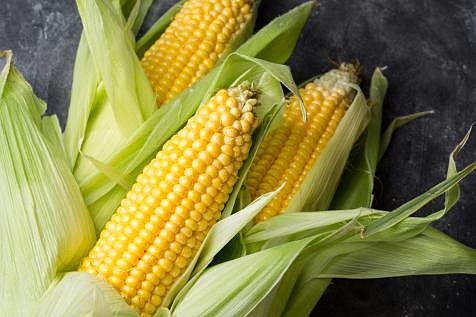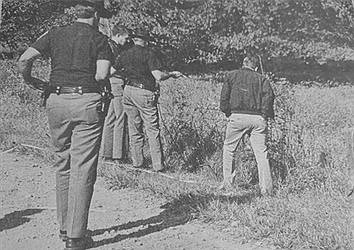It’s sweet corn season in Indiana! Here’s what to do with all that corn
August 9, 2023 at 12:40 a.m.

In Indiana, known as a "Corn Belt" state, a landscape filled with rows of corn has long felt like home to residents in all parts of the state. Hoosiers boast a plethora of corn varieties, each with its unique characteristics. Among the most prevalent types are dent corn, sweet corn, and popcorn. Dent corn, also known as field corn, is primarily cultivated for livestock feed, ethanol production, and industrial purposes. Its distinct "dented" kernels make up the majority of our cornfields, a highlight of the state’s agricultural productivity. When driving across Indiana, this is the most common corn variety you encounter– what tourists would consider a typical cornfield in the Midwest. Field corn can reach heights of approximately 10 feet and is harvested in the autumn when the kernels have dried. It finds widespread use as animal feed and is also utilized in renewable fuel production, though there are dozens of other uses for this type of corn.
But it’s the sweet corn here that both residents and visitors alike look forward to each summer. It is noticeably shorter and smaller than other corn varieties, with less thick and upright leaves. Unlike the corn types harvested in autumn, sweet corn is picked during the summer when its flavor reaches perfection. This variety, characterized by its crisp, sweet flavor, is seasonally eaten as a fresh vegetable, often sold at local roadside stands and farmers' markets or shared with neighbors and friends. If you find yourself with a surplus of this beloved summer treat, here are some ideas! For a quick and delicious creamy corn, here is what The Pioneer Woman recommends:
Ingredients
8 ears corn, still in the husk
2/3 c. heavy cream
3 tbsp. butter (salted)
1/2 tsp. salt, to taste
Ground pepper, to taste
Directions
Remove the corn from the husks. In a large, deep bowl, slice off the kernels of corn. With the dull side of the knife (or a regular dinner knife), press and scrape the cob all the way down to remove all the bits of kernel and creamy milk inside. Scrape all of it out, the sweet liquid off the cob is essential to this dish!
Add heavy cream, salt to taste, a generous amount of ground pepper and butter; mix well. Pour mixture into a baking dish. Bake at 350Fº for 30 to 45 minutes or until thoroughly warmed through.
What else can you do with all of that sweet corn? Thankfully, sweet corn happens to be one of the most versatile foods on earth. Here are some more ideas:
Freeze it! There are few things better than taking sweet corn kernels, cut freshly from a cob in the summer, and freezing them for use on a cold winter day. There are a number of ways to do this. You can simply shuck whole ears, put them in freezer bags, and remove the excess air. You can cut the kernels off an uncooked ear and save them. Or you can cook the ears first, then cut off the kernels. (Just be sure to note whether the kernels are cooked or not.)
Make salsa! Sweet corn kernels cut from the ear make a great addition to almost any salsa recipe. Traditional tomato salsas, black bean salsas, sweeter mango salsas…all could benefit from sweet corn. This is a good way to use those tomatoes and peppers from the garden as well!
Make soup! There are dozens of soups and chowders that work wonderfully with fresh sweet corn. You can definitely add sweet corn to lots of different soups, from vegetable beef soup to chili to chowder. You can freeze these for cooler weather, too.
Make tacos! Take leftover sweet corn kernels and mix them with a bit of seasoning (a dash of chili powder is great) then heat them up. They make for a great taco addition.
Make succotash! Succotash is just a mix of corn, tomatoes, onions, and lima beans with some seasonings. You simply cook those things together in a skillet and add some thyme, garlic, dill, and chives, along with some butter. It works as a great side dish with chicken, for example.
Make cornbread! You don’t have to make the actual cornmeal here…sweet corn kernels are a lovelyt addition to cornbread. Just take your favorite corn bread mix or cornbread recipe and add half a cup of cooked sweet corn kernels right into the mix, then cook as normal (adding perhaps a minute or two to the baking).
Make pancakes! Believe it or not, sweet corn makes a wonderful addition to pancakes. When you slather them with maple syrup, the little sweetness and the texture addition that sweet corn kernels give to the cakes is something well worth savoring. Just make pancakes as you normally would, but simply add a cup of kernels to every three to four cups of batter. This will stretch the batter a bit, enabling you to make more pancakes while also providing this unique flavor and texture.
Make salad! You can add a wonderful texture and flavor to many different salads by simply adding a cup of cooked corn kernels cut straight from the cob (or thawed from being frozen at an earlier date). Most simple dinner salads benefit greatly from the addition of corn kernels, plus there are many different salads you can make that emphasize the kernels.
Try this corn and tomato salad. It’s what it sounds like – fresh corn kernels, cherry or grape tomatoes, plus some mozzarella, some olive oil, some vinegar, basil, green onions, and a bit of black pepper. Delicious!
Make a casserole! There are many, many casserole recipes that use fresh sweet corn kernels. Some serve as wonderful side dishes, while others work as main courses on their own.
Latest News
E-Editions
Events
In Indiana, known as a "Corn Belt" state, a landscape filled with rows of corn has long felt like home to residents in all parts of the state. Hoosiers boast a plethora of corn varieties, each with its unique characteristics. Among the most prevalent types are dent corn, sweet corn, and popcorn. Dent corn, also known as field corn, is primarily cultivated for livestock feed, ethanol production, and industrial purposes. Its distinct "dented" kernels make up the majority of our cornfields, a highlight of the state’s agricultural productivity. When driving across Indiana, this is the most common corn variety you encounter– what tourists would consider a typical cornfield in the Midwest. Field corn can reach heights of approximately 10 feet and is harvested in the autumn when the kernels have dried. It finds widespread use as animal feed and is also utilized in renewable fuel production, though there are dozens of other uses for this type of corn.
But it’s the sweet corn here that both residents and visitors alike look forward to each summer. It is noticeably shorter and smaller than other corn varieties, with less thick and upright leaves. Unlike the corn types harvested in autumn, sweet corn is picked during the summer when its flavor reaches perfection. This variety, characterized by its crisp, sweet flavor, is seasonally eaten as a fresh vegetable, often sold at local roadside stands and farmers' markets or shared with neighbors and friends. If you find yourself with a surplus of this beloved summer treat, here are some ideas! For a quick and delicious creamy corn, here is what The Pioneer Woman recommends:
Ingredients
8 ears corn, still in the husk
2/3 c. heavy cream
3 tbsp. butter (salted)
1/2 tsp. salt, to taste
Ground pepper, to taste
Directions
Remove the corn from the husks. In a large, deep bowl, slice off the kernels of corn. With the dull side of the knife (or a regular dinner knife), press and scrape the cob all the way down to remove all the bits of kernel and creamy milk inside. Scrape all of it out, the sweet liquid off the cob is essential to this dish!
Add heavy cream, salt to taste, a generous amount of ground pepper and butter; mix well. Pour mixture into a baking dish. Bake at 350Fº for 30 to 45 minutes or until thoroughly warmed through.
What else can you do with all of that sweet corn? Thankfully, sweet corn happens to be one of the most versatile foods on earth. Here are some more ideas:
Freeze it! There are few things better than taking sweet corn kernels, cut freshly from a cob in the summer, and freezing them for use on a cold winter day. There are a number of ways to do this. You can simply shuck whole ears, put them in freezer bags, and remove the excess air. You can cut the kernels off an uncooked ear and save them. Or you can cook the ears first, then cut off the kernels. (Just be sure to note whether the kernels are cooked or not.)
Make salsa! Sweet corn kernels cut from the ear make a great addition to almost any salsa recipe. Traditional tomato salsas, black bean salsas, sweeter mango salsas…all could benefit from sweet corn. This is a good way to use those tomatoes and peppers from the garden as well!
Make soup! There are dozens of soups and chowders that work wonderfully with fresh sweet corn. You can definitely add sweet corn to lots of different soups, from vegetable beef soup to chili to chowder. You can freeze these for cooler weather, too.
Make tacos! Take leftover sweet corn kernels and mix them with a bit of seasoning (a dash of chili powder is great) then heat them up. They make for a great taco addition.
Make succotash! Succotash is just a mix of corn, tomatoes, onions, and lima beans with some seasonings. You simply cook those things together in a skillet and add some thyme, garlic, dill, and chives, along with some butter. It works as a great side dish with chicken, for example.
Make cornbread! You don’t have to make the actual cornmeal here…sweet corn kernels are a lovelyt addition to cornbread. Just take your favorite corn bread mix or cornbread recipe and add half a cup of cooked sweet corn kernels right into the mix, then cook as normal (adding perhaps a minute or two to the baking).
Make pancakes! Believe it or not, sweet corn makes a wonderful addition to pancakes. When you slather them with maple syrup, the little sweetness and the texture addition that sweet corn kernels give to the cakes is something well worth savoring. Just make pancakes as you normally would, but simply add a cup of kernels to every three to four cups of batter. This will stretch the batter a bit, enabling you to make more pancakes while also providing this unique flavor and texture.
Make salad! You can add a wonderful texture and flavor to many different salads by simply adding a cup of cooked corn kernels cut straight from the cob (or thawed from being frozen at an earlier date). Most simple dinner salads benefit greatly from the addition of corn kernels, plus there are many different salads you can make that emphasize the kernels.
Try this corn and tomato salad. It’s what it sounds like – fresh corn kernels, cherry or grape tomatoes, plus some mozzarella, some olive oil, some vinegar, basil, green onions, and a bit of black pepper. Delicious!
Make a casserole! There are many, many casserole recipes that use fresh sweet corn kernels. Some serve as wonderful side dishes, while others work as main courses on their own.





